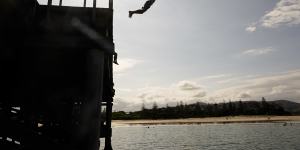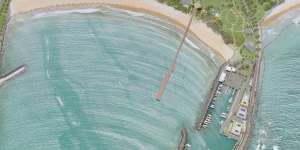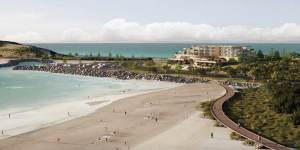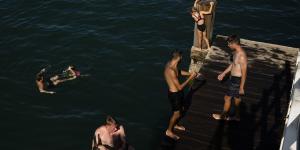The state government wants to build up to 250 homes and 200 short-stay units for tourists in Coffs Harbour on land it owns behind the Jetty Beach and Park. It says the plan will meet housing needs and boost tourism in Coffs,which has been losing visitors over the past few decades to rising regional stars like Yamba and Byron Bay.

Teenagers jump off the Coffs Harbour jetty,with the foreshore in the background.Janie Barrett
The land in question is used for overflow parking and illegal camping,or fenced off in a railway corridor. The development would fund a park upgrade at the jetty that would include an adventure playground with water play,a boardwalk and sports courts. The upgrade would be delivered over 20 years.
But the draft masterplan,produced after four years of community consultation,has caused uproar in Coffs Harbour,with some residents and the local council fearing a much-loved natural space and point of difference for tourists is about to be lost to overdevelopment.
A community survey used to gauge local views found that while younger people broadly supported building accommodation of up to six storeys at the site if it was used to fund the park upgrade,those aged over 55 were mostly against it.
“This is the heart and soul of Coffs Harbour,” independent Mayor Paul Amos said. “The whole concept is not workable. It’s simply going to destroy the place.[At that size] it’s like one of our small villages on the outskirts of Coffs. You’re really creating a new suburb in an already densely populated area.”

An artist’s impression of the draft masterplan,which would develop land east of the railway line.Supplied
He said the development would add “hundreds of millions of dollars” to state coffers and Coffs Harbour did not have a housing supply issue,with hundreds of apartments already approved and waiting to be built and other areas in the city rezoned to allow for five-storey dwellings on existing house blocks.
Property and Development NSW,which sits within the Department of Planning,is preparing an application to rezone the foreshore land. It said all funds generated by selling off the rezoned land would be invested back into the precinct. It would cost at least $15 million to provide basic essentials for the upgrade,but the full design is yet to be costed.
Amos has proposed an alternative plan for the foreshore,with less development and more parkland,which he says would be better for residents and tourists.
“We’ve got space to breathe,and the beautiful beach there,” he said. “It’s something different from everywhere else on the coast now,and there’s potential to improve on that. We will lose that potential if we build on that land.”

An artist’s impression of a boardwalk and “regional tourist destination” with accommodation and cafes envisioned for the Coffs Harbour jetty foreshore.Supplied
But state Nationals member Gurmesh Singh,who supports revitalising the foreshore,said Coffs was in the grip of a housing shortage,was losing its younger residents and needed to revitalise tourism.
“Coffs Harbour has got objectively some of the best beaches in NSW but we don’t have a waterfront precinct that takes advantage of those beaches,” he said.
“Instead you see cities like Ballina and Port Macquarie that have taken better advantage of more limited waterfront precincts,and have a more modern tourism offering.
“A lot of people[aged 20-40] leave Coffs for other regions that have more of every type of opportunity – be it work or social life – but to build a good city,you need a good balance of people.”

The proportion of people aged over 64 in Coffs rose 2.1 percentage points between 2016 and 2021,to 23.1 per cent of the population. The number of those aged 20-39 grew one percentage point,to 21.8. Overall,the population grew 8 per cent.
Resident Lauren Smith,a designer,said the foreshore proposal was well planned. She said the city needed more drawcards because it was losing out to places with better facilities.
“The one thing you see on Facebook is ‘what can kids do here besides the Big Banana?’ ” she said. “It’s a seaside town full of an ageing population,and it’s hard for the younger generations to get a vote in.
“Young people need jobs and homes,and they’re all going to leave Coffs if they don’t feel supported by the community.”

Swimmers enjoy one of the last dips of summer off the Coffs Harbour jetty in February.Janie Barrett
Coffs Harbour was the only local government area on the north coast to record a fall in tourism numbers between 2013 and 2019. Visits fell by 1 per cent,when the broader region north of Port Macquarie. Byron Shire recorded growth of 57 per cent.
The Coffs Harbour City Council published a new tourism strategy in November to rebrand the city as an “eco-destination” in an attempt to grow the industry and attract higher-spending types of tourists. As it stands,the industry is worth more than $280 million a year to the local economy.
Last month,the council voted to try to compulsorily acquire the jetty foreshore land from the government,to stop the masterplan going ahead. The state minister for local government would have to approve that application.

Florence and Mabel McKay visit The Big Banana in Coffs Harbour.Janie Barrett
The council also offered to swap two blocks in the Coffs CBD for the foreshore land,but Property and Development NSW rejected the proposal,saying it did not represent value and would not achieve the same objectives as the foreshore development.
A spokesperson for Property and Development NSW said the project would turn an underused area into a “family playground”,support the economy,and help achieve local and state planning goals.
“Coffs Harbour has undergone significant change over the years. As a regional city,there is a need to reimagine its direction,” the spokesperson said.
Start the day with a summary of the day’s most important and interesting stories,analysis and insights..